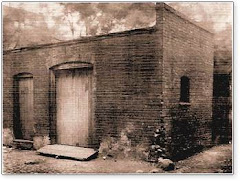HTML clipboard Bailout; Wall Street's 75-Year Structural Round Trip
1932 - Commercial banks and Private Partnerships (family financial dynasties) - Goldman, Sachs, Kidder, Peabody, Kuhn Loeb, Lehman Brothers, others
June 16, 1933 - President Franklin D. Roosevelt signed (second) Glass Steagall Act (Banking Act of 1933) as emergency response to failure of nearly 5,000 banks during Great Depression (bank failures resulted in losses to depositors of about $1.3 billion between 1929-1933); separated commercial from investment banking (provide capital to American business); tightened regulation of national banks to Federal Reserve System; prohibited bank sales of securities; created Federal Deposit Insurance Corporation (FDIC) to insure bank deposits with pool of money appropriated from banks).
HTML clipboard 
Senator Carter Glass (D-VA, third from left); Representative Henry B. Steagall (D-AL, fourth from right) (http://www.senate.gov/artandhistory/history/resources/graphic/large/Glass.jpg)
HTML clipboard 1930s-1970s - Relationship Banking
September 16, 1935 - Henry S. Morgan, Harold Stanley, former partners in J. P. Morgan & Co.; opened Morgan Stanley on 19th floor of 2 Wall Street; 1936 - managed $1.1 billion in public offerings, private placements in first year (24% market share); 1971 - entered sales, trading business, established M&A division.
1973 - Derivatives - Fisher Black, Myron Scholes published Black-Scholes Option Pricing Formula in Journal of Political Economy; specified first successful options pricing formula (mathematics of option pricing, dynamic hedging strategies using options and other derivatives); described general framework for pricing derivative securities, created financial engineering; one of most important mathematical tools in modem theory of finance (Black, F. and Scholes, M. [1973]. "The Pricing of Options and Corporate Liabilities". Journal of Political Economy, Vol. 86, p.637). April 26, 1973 - Chicago Board Options Exchange opened for trading (911 contracts on 16 underlying stocks); 1997 - Black (posthumously), Scholes, Merton Miller awarded Nobel Prize in Economic Sciences "for a new method to determine the value of derivatives."
1974 - Central Bank Governors of the Group of Ten countries created Basel Committee on Banking Supervision to provide forum for regular cooperation on banking supervisory matters, to enhance understanding of key supervisory issues, improve quality of banking supervision worldwide; formulates broad supervisory standards and guidelines; recommends statements of best practice; members come from Belgium, Canada, France, Germany, Italy, Japan, Luxembourg, Netherlands, Spain, Sweden, Switzerland, United Kingdom, United States; represented by central bank, by authority with formal responsibility for prudential supervision of banking business where this is not central bank; 12 member permanent fifteen person Secretariat located at Bank for International Settlements in Basel, Switzerland; 1988 - Committee introduced capital measurement system (Basel Capital Accord); provided for implementation of credit risk measurement framework with minimum capital standard of 8% by end-1992; June 1999 - issued proposal for revised Capital Adequacy Framework (minimum capital requirements, supervisory review of an institution's internal assessment process and capital adequacy; effective use of disclosure to strengthen market discipline as complement to supervisory efforts); June 26, 2004 - Basel II (revised framework) issued; rules for measuring bank risk, determining capital adequacy to absorb risk.HTML clipboard 1974 - Michael Milken created market for high-yield bond trading; based on research of W. Braddock Hickman, former president of the Federal Reserve Bank of Cleveland (Corporate Bond Quality and Investor Experience, Princeton, NJ: Princeton University Press, 1958) - corporate default history 1900-1943: diversified long-term portfolio of non-investment-grade debt securities outperformed portfolio of investment-grade debt, with the same level of risk.
April 1977 - Junk Bonds - Drexel underwrote first junk bond issue, Texas International; end of 1978 - Drexel number one issuer; used financial innovation as low-cost solution to raising capital; created high-yield new-issue bond market; 1981 - issued bonds for leveraged buyouts; 1983 - provided junk bond financing for hostile takeovers (leveraged buyouts taken against incumbent directors’ will); March 1985 - completed first junk bond-financed hostile takeover.
1977 - LBOs - Kohlberg Kravis Roberts & Co. (formed in May 1, 1976 by former Bear Stearns executives Jerome Kohlberg, Henry Kravis, George Roberts) financed $26 million leveraged buyout of A.J. Industries, publicly-traded small manufacturer of brake drums and other components (66% leverage financed with senior bank debt); firms' first deal; couldn't persuade anyone to provide subordinated debt (first LBO done in 1963 - Lewis B. Cullman acquired Orkin Exterminating for $62.4 million with a $1,000 investment); May 14, 1979 - acquired Houdaille Industries in $355 million buyout; first public-to-private transaction (leveraged buyout of a publicly traded company); took almost one year to raise $355 million from several banks, insurance companies for deal with 86% leverage financed by multi-layered array of senior, subordinated securities.
1977 - Securitization - Salomon Brothers (Lewis S. Ranieri) and Bank of America Corp. (BAC ) developed first private (non-Government Sponsored Enterprise) mortgage-backed securities (MBS); bonds pooled thousands of mortgages, passed homeowners' payments through to investors (only 15 states recognized MBS as legal investments); created "securitization," converting of home loans into bonds that could be sold anywhere in world = capital markets as source of funds for housing, commercial real estate; 1982 - developed "collateralized mortgage obligation" (repackaged pools of 30-year mortgages into collections of 2-, 5-, and 10-year bonds to sell to wide range of investors; seen as template for cutting costs); led effort to obtain federal legislation to support, build the market (Tax Reform Act of 1986); 1999 - size of market was $678 billion (41.6% credit card receivables, 19.8% home equity loans, 11.8% auto loans).
HTML clipboard 1979 - End of relationship banking - I.B.M. told Morgan Stanley that it wanted Salomon Brothers to co-manage a $1 billion debt issue; traditional corporate clients outgrew their bankers; underwriting deteriorated into low-margin business vs. trading.
1980s - Transactional banking to facilitate corporate restructuring: mergers & acquisitions, tender offers, hostile takeovers, leveraged buyouts, divestitures, spin-offs, 'junk bonds'; trading (equities, commodities, derivatives); prime brokerage for hedge funds.
November 12, 1999 - President Bill Clinton signed Gramm-Leach-Bliley Act (Financial Services Modernization Act of 1999); named for Senator Phil Gramm (R-TX), Representative Jim Leach (R-IA), Representative Thomas J. Bliley, Jr. (R-VA); repealed restrictions on banks affiliating with securities firms contained in sections 20 and 32 of the Glass-Steagall Act. Gramm's Statement at Signing ceremony (11/12/1999) - "We are here today to repeal Glass-Steagall because we have learned that government is not the answer. We have learned that freedom and competition are the answers. We have learned that we promote economic growth and we promote stability by having competition and freedom. "I am proud to be here because this is an important bill; it is a deregulatory bill. I believe that that is the wave of the future, and I am awfully proud to have been a part of making it a reality."
June 9, 2004 - SEC issued Final Rule on "Alternative Net Capital Requirements for Broker-Dealers That Are Part of Consolidated Supervised Entities"; permitted "a broker-dealer to use mathematical models to calculate net capital requirements for market and derivatives-related credit risk"; reduced amount of capital that had to underlie assets; allowed increased leverage.
HTML clipboard July 17, 2007 - Bear Stearns High-Grade Structured Credit Fund (started in 2004, posted 41 months of positive returns of about 1 - 1.5%/month) lost more than 90% of its value (about $900 million), Bear Stearns High-Grade Structured Credit Enhanced Leveraged Fund (started in 2006) lost 100% or $600 million (collateralized debt obligations + leverage + credit default swaps to hedge against moves in credit market); declines in values subprime mortgage-backed securities exceeded insurance hedge; leverage intensified losses; equivalent of 'margin call' by lenders required selling bonds to raise cash; July 31, 2007 - funds filed for Chapter 15 bankruptcy protection.
2008 - Trading Risk - What they really don't teach you at Harvard Business School: leverage (to generate returns to justify fund management fees - Bear Stearns's operated at a 33:1 leverage ratio; Lehman was 32-to-1) + concentrated portfolio (in one asset type - mortgages) + illiquidity (they 'were' the market) + event risk (unexpected collapse of subprime bond market) can = disaster (Long-Term Capital Management, Bear Stearns, Lehman Brothers Holdings, AIG, etc., etc., etc.).




